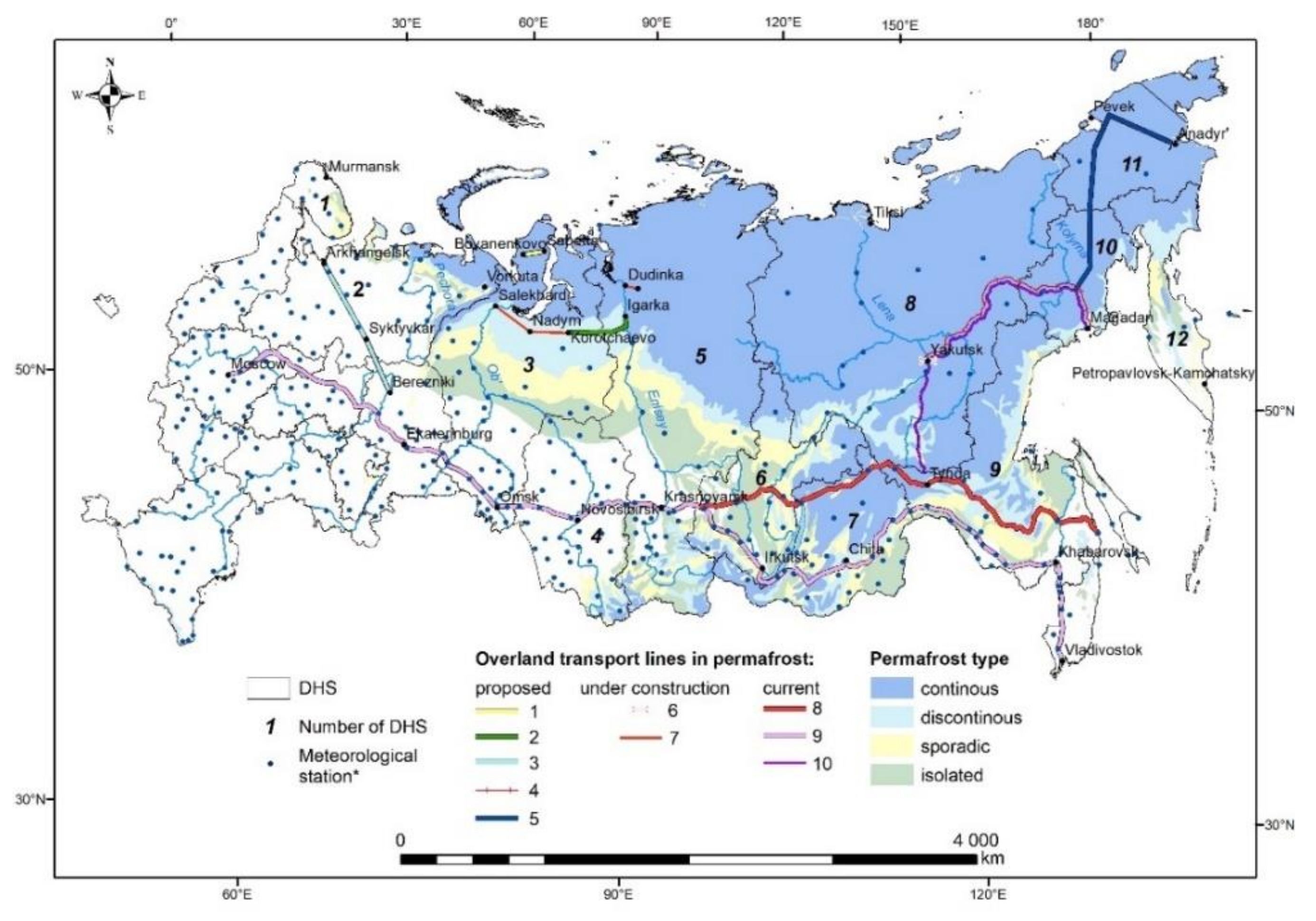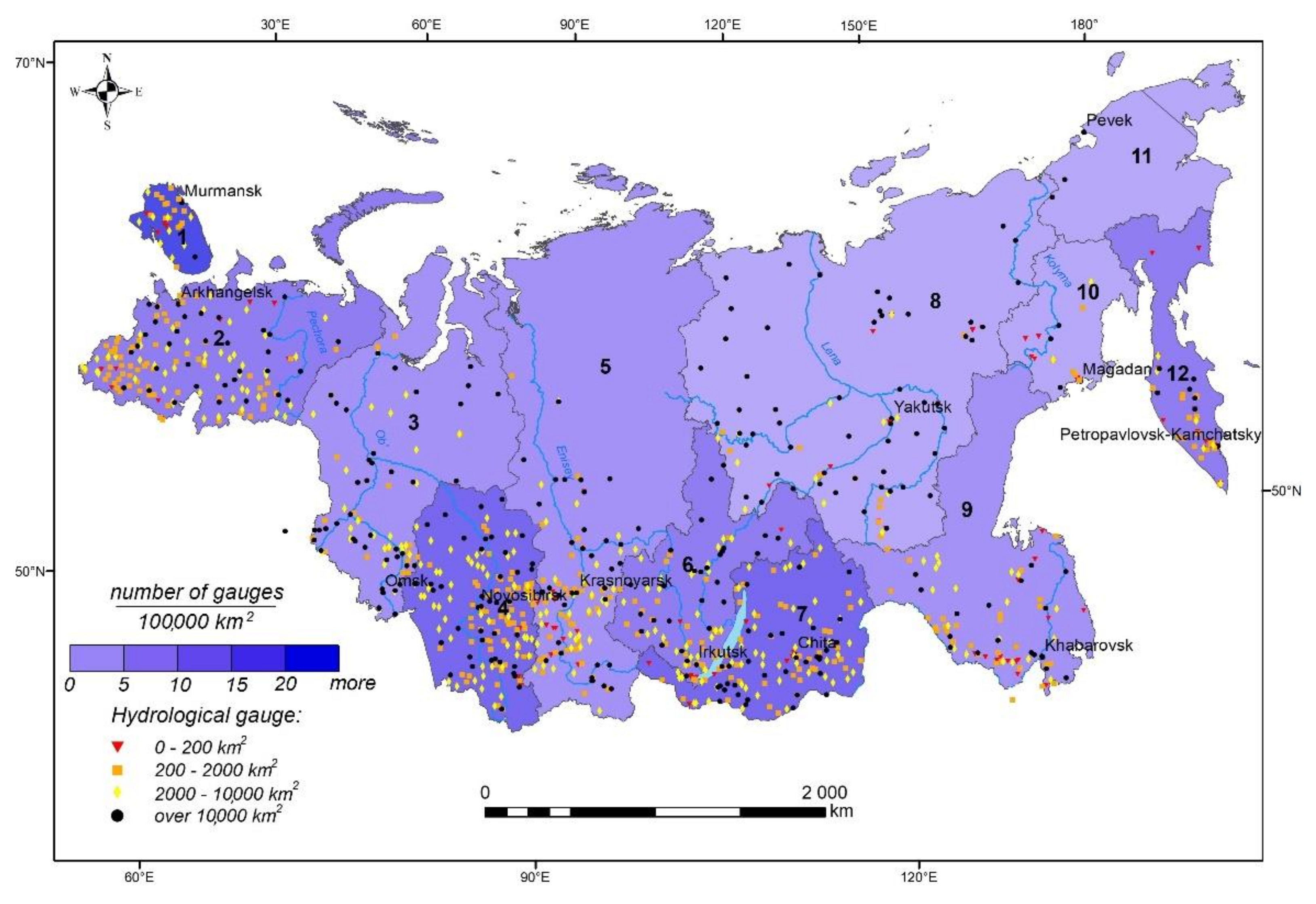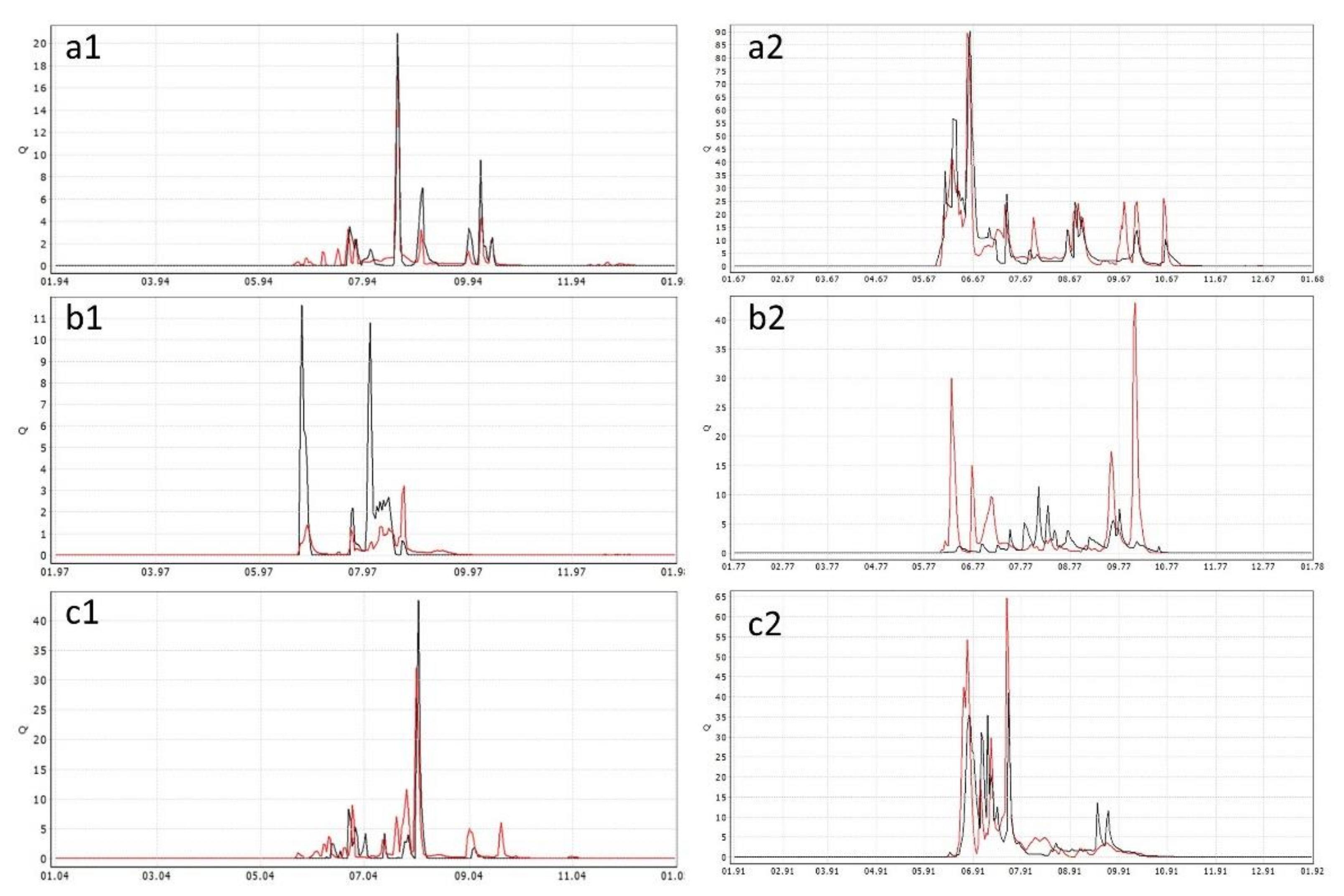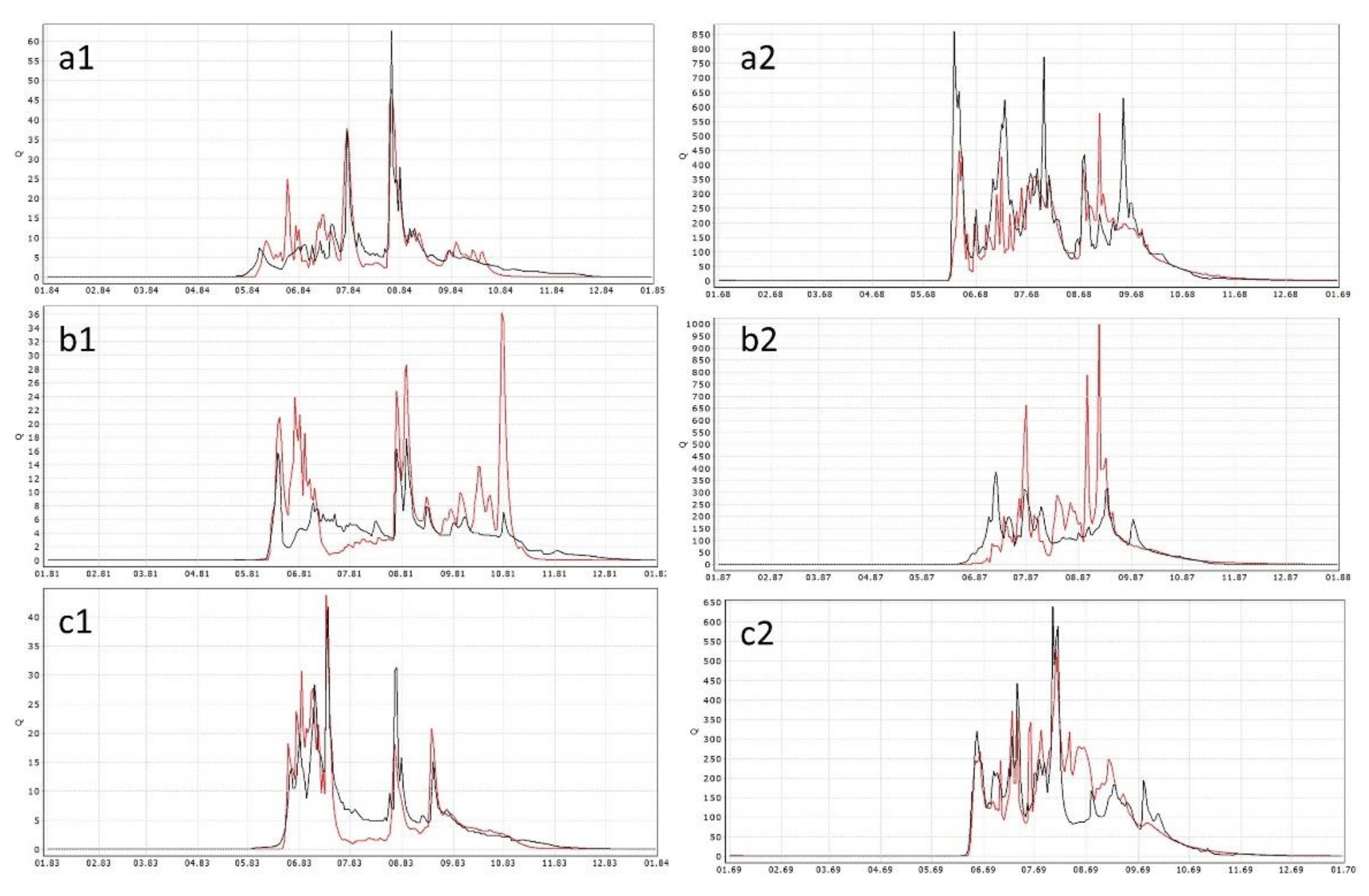Challenges of Hydrological Engineering Design in Degrading Permafrost Environment of Russia
Abstract
1. Introduction
2. Study Area and Permafrost Data Availability
2.1. Soil Temperature Observation in Permafrost Zone of Russia
2.2. Reduction in Hydrological Observation Network in Permafrost Zone of Russia
3. Methods
3.1. Modern Methods for Calculating the Hydrological Engineering Characteristics
3.2. The Mathematical Modeling Methods and Special Monitoring of Runoff Formation Processes in the Permafrost Zone
3.3. Hydrograph Model
4. Results
| Large River Basin | River | S * | H | Pr | Yo | Ys | P | E | Qo | Qs | NS (av) | NS (max) |
|---|---|---|---|---|---|---|---|---|---|---|---|---|
| Indigirka | Sakharynia | 84.4 | 833 | 1966–2012 | 93 | 113 | 294 | 181 | 14 | 12 | 0.32 | 0.76 |
| Artyk-Yuryah | 644 | 591 | 1966–1991 | 82 | 81.8 | 274 | 189 | 90.3 | 149 | 0.14 | 0.72 | |
| Yana | Charky | 8290 | 274 | 1966–2007 | 216 | 223 | 361 | 120 | 1424 | 1490 | 0.34 | 0.70 |
| Kolyma | Anmangynda | 400 | 668 | 1966–1987 | 273 | 237 | 375 | 125 | 161 | 81.1 | 0.43 | 0.71 |
5. Conclusions
- The development of a state program to organize a network of representative catchments in various climatic zones of permafrost regions for the comprehensive monitoring of main components of water balance and hydrological processes using modern equipment with a high time resolution and new research methods. It is also necessary to consider the feasibility of restoring historical stations with a long series of observations, such as the Kolyma water balance station [56]. The development of such a program should be based on the results of a detailed inventory of historical data of standard and specialized information on the characteristics of the natural environment (climate, permafrost, hydrology, hazardous phenomena, landscapes, etc.). The research stations should be equipped for year-round living and may serve educational purposes for student field practice and experience in the future.
- 2.
- State order for the development of approaches for the estimation of the main hydrological characteristics in engineering and survey design tasks based on mathematical modeling methods.
- 3.
- Improvement (in particular, expansion) of the standard hydrological observation network, based on modern modeling and remote sensing methods and accounting for historical experience, and social and economic development programs [72]. The improvement of the measurements’ quality would require the renewal and expansion of hydrometeorological education which has been in deep decline for the last 30 years.Implementing these three tasks would require us to solve many problems. Among them are an acute shortage of qualified specialists in hydrometeorology (from observers to researchers), the loss of experience in organizing and conducting complex hydrological research, a lag in the development of modern hydrometeorological devices’ domestic production, financing of the industry on a residual basis, and others.
Author Contributions
Funding
Institutional Review Board Statement
Informed Consent Statement
Data Availability Statement
Conflicts of Interest
References
- The Intergovernmental Panel on Climate Change (IPCC). Available online: https://www.ipcc.ch/reports/ (accessed on 20 October 2021).
- Walvoord, M.A.; Kurylyk, B.L. Hydrologic Impacts of Thawing Permafrost—A Review. Vadose Zone J. 2016, 15, 6. [Google Scholar] [CrossRef]
- Bring, A.; Fedorova, I.; Dibike, Y.; Hinzman, L.; Mård, J.; Mernild, S.H.; Prowse, T.; Semenova, O.M.; Stuefer, S.L.; Woo, M.-K. Arctic terrestrial hydrology: A synthesis of processes, regional effects, and research challenges. J. Geophys. Res. Biogeosciences 2016, 121, 621–649. [Google Scholar] [CrossRef]
- Kattsov, V.M.; Kallen, E.; Cattle, H.; Christensen, J.; Drange, H.; Hanssen-Bauer, I.; Johannesen, T.; Karol, I.; Raisanen, J.; Svensson, G.; et al. Future climate change: Modeling and scenarios for the Arctic. In ACIA; Cambridge University Press: Cambridge, UK, 2005; pp. 99–150. [Google Scholar]
- Rawlins, M.A.; Serreze, M.C.; Schroeder, R.; Zhang, X.; McDonald, K.C. Diagnosis of the record discharge of Arctic-draining Eurasian Rivers in 2007. Environ. Res. Lett. 2009, 4, 045011. [Google Scholar] [CrossRef][Green Version]
- Alekseevskii, N.I.; Magritskii, D.V.; Mikhailov, V.N. Anthropogenic and natural changes in hydrological restrictions for the use of natural resources in the deltas of the Russian Arctic. Water Manag. Russ. Probl. Technol. Manag. 2015, 1, 14–31. [Google Scholar]
- Yang, D.; Kane, D.L.; Hinzman, L.; Zhang, X.; Zhang, T.; Ye, H. Siberian Lena River hydrologic regime and recent change. J. Geophys. Res. 2002, 107, ACL-14. [Google Scholar] [CrossRef]
- Tananaev, N.I.; Makarieva, O.M.; Lebedeva, L.S. Trends in annual and extreme flows in the Lena River basin, Northern Eurasia. Geophys. Res. Lett. 2016, 43, 10764–10772. [Google Scholar] [CrossRef]
- Ridder, N.N.; Pitman, A.J.; Westra, S.; Ukkola, A.; Do, H.X.; Bador, M.; Hirsch, A.L.; Evans, J.P.; Di Luca, A.; Zscheischler, J. Global hotspots for the occurrence of compound events. Nat. Commun. 2020, 11, 5956. [Google Scholar] [CrossRef]
- Anisimov, O.; Streletskiy, D. Geocryological Hazards of Thawing Permafrost. Arctika XXI Century 2015, 2, 60–74. (In Russian) [Google Scholar]
- Kolokolova, N.A.; Garris, N.A. About the choice of method of laying pipelines in permafrost. J. THNP 2013, 1, 13–17. (In Russian) [Google Scholar]
- Akimov, V.A.; Sokolov, Y.I.; Sosunov, I.V. Global and National Priorities for Disaster Risk Reduction; VNII GOChS (FC) All-Russian Research Institute for Civil Defence of the EMERCOM of Russia (the Federal Science and High Technology Center): Moscow, Russia, 2016; 396p. (In Russian) [Google Scholar]
- Pravdaurfo.ru. A New Section of the Destroyed Salekhard-Nadym Highway Is Blocked in YANAO. Available online: https://pravdaurfo.ru/novost/v-yanao-perekryvayut-novyj-uchastok-razrushennoj-trassy-salekhard-nadym/ (accessed on 20 November 2021). (In Russian).
- Ria.ru. Traffic Was Closed on the Kolyma Highway Section due to Flooding. Available online: https://ria.ru/society/20170717/1498659385.html (accessed on 19 April 2018). (In Russian).
- Newizv.ru. The flood in the Magadan region broke the record of 1939. Available online: https://newizv.ru/news/incident/06-08-2019/navodnenie-v-magadanskoy-oblasti-pobilo-rekord-1939-goda (accessed on 20 November 2021). (In Russian).
- Gosudarstvennaja Programma Rossijskoj Federacii «Social’no-Jekonomicheskoe Razvitie Arkticheskoj Zony Rossijskoj Federacii», Utverzhdena Postanovleniem Pravitel’stva Rossijskoj Federacii ot 21 Aprelja 2014 g. № 366 (v Redakcii Postanovlenija Pravitel’stva Rossijskoj Federacii ot 31 Avgusta 2017 g. № 1064). The State Program of the Russian Federation “Socio-Economic Development of the Arctic Zone of the Russian Federation”. Approved by the Government of the Russian Federation of April 21, 2014, No. 366 (as Amended by Government Decree No. 1064 of 31 August 2017). Available online: http://static.government.ru/media/files/GGu3GTtv8bvV8gZxSEAS1R7XmzloK6ar.pdf (accessed on 19 April 2018). (In Russian)
- Regnum.ru. A Railway from Yakutia to Magadan Can Be Built along the Kolyma Highway. Available online: https://regnum.ru/news/economy/3352653.html (accessed on 20 November 2021). (In Russian).
- Interfax.ru. The Construction of a Bridge across the Lena River in Yakutia Will Be Half Paid by the State. Available online: https://www.interfax.ru/russia/757608 (accessed on 20 November 2021). (In Russian).
- Prikaz Ministerstva Ekonomicheskogo Razvitiya Rossijskoj Federacii (MINEKONOMRAZVITIYA Rossii) №267 ot 13 Maya 2021 g. Ob Utverzhdenii Metodicheskih Rekomendacij i Pokazatelej po Voprosam Adaptacii k Izmeneniyam Klimata. Order of the Ministry of Economic Development of the Russian Federation No. 267 Dated May 13, 2021 On Approval of Methodological Recommendations and Indicators on Adaptation to Climate Change. Available online: https://www.economy.gov.ru/material/file/b3cc582c24e7367170b5605f1199c6a9/267_13052021.pdf (accessed on 9 October 2021). (In Russian)
- Brown, J.; Ferrians, O.J., Jr.; Heginbottom, J.A.; Melnikov, E.S. 211 Circum-Arctic Map of Permafrost and Ground-Ice Conditions. Available online: https://nsidc.org/212data/ggd318.html (accessed on 1 December 2021).
- Hydrometeorological Information—World Data Center. Available online: http://meteo.ru/ (accessed on 5 September 2021). (In Russian).
- Makarieva, O.M.; Nesterova, N.V.; Beldiman, I.N.; Lebedeva, L.S. Actual Problems of Hydrological Assessments in the Arctic Zone of Russian Federation and Adjacent Permafrost Territories. Прoблемы Арктики и Антарктики 2018, 64, 101–118. [Google Scholar] [CrossRef]
- USSR State Committee for Hydrometeorology and Environmental Control. State Water Cadastre. Long-Term Data on the Regime and Resources of Land Surface Waters; 1 (15); Gidrometeoizdat: Leningrad, USSR, 1986. (In Russian) [Google Scholar]
- USSR State Committee for Hydrometeorology and Environmental Control. State Water Cadastre. Long-Term Data on the Regime and Resources of Land Surface Waters; 1 (16); Gidrometeoizdat: Leningrad, USSR, 1987. (In Russian) [Google Scholar]
- USSR State Committee for Hydrometeorology and Environmental Control. State Water Cadastre. Long-Term Data on the Regime and Resources of Land Surface Waters; 1 (17); Gidrometeoizdat: Leningrad, USSR, 1985. (In Russian) [Google Scholar]
- Automated Information System of State Monitoring of Water Bodies. Available online: https://gmvo.skniivh.ru/ (accessed on 5 September 2021). (In Russian).
- Gelder, P.H.A.J.M. Statistical Estimation Methods in Hydrological Engineering. In Proceedings of the International Scientific Seminar, Irkutsk, Russia, 16–23 June 2003; Korytny, L.M., Luxemburg, W.M., Eds.; Publishing House of the Institute of Geography: Moscow, Russia, 2004; p. 11. [Google Scholar]
- England, J.F., Jr.; Cohn, T.A.; Faber, B.A.; Stedinger, J.R.; Thomas, W.O.; Veilleux, A.G., Jr.; Kiang, J.E.; Mason, R.R., Jr. Guidelines for determining flood flow frequency—Bulletin 17C. In Techniques and Methods; Book 4; U.S. Geological Survey: Reston, VA, USA, 2019; Chapter 5; p. 148. [Google Scholar] [CrossRef]
- World Meteorological Organization. Technical Note, No. 98. Estimation of Maximum Floods: Report of a Working Group; Secretariat of the World Meteorological Organization: Geneva, Switzerland, 1969; Volume 233, p. 208. [Google Scholar]
- Asquith, W.H.; Slade, R.M. Documented and potential extreme peak discharges and relation between potential extreme peak discharges and probable maximum flood peak discharges in Texas. In U.S. Geological Survey Water-Resources Investigations Report 95–4249; U.S. Geological Survey: Reston, VA, USA, 1995; p. 58. Available online: https://pubs.er.usgs.gov/publication/wri954249 (accessed on 1 December 2021).
- Singh, A.; Singh, V.P.; Byrd, A.R. Computation of probable maximum precipitation and its uncertainty. Int. J. Hydrol. 2018, 2, 504–514. [Google Scholar] [CrossRef]
- Madsen, H.; Lawrence, D.; Lang, M.; Martinkova, M.; Kjeldsen, T.R. (Eds.) A Review of Applied Methods in Europe for Flood Frequency Analysis in a Changing Environment; Centre for Ecology & Hydrology on behalf of COST: Swindon, UK, 2012; p. 189. [Google Scholar]
- Federal Hydrologic and Hydraulic Procedures for Flood Hazard Delineation Version 1.0 2019 Natural Resources Canada General Information Product 113e.; Natural Resources Canada—Public Safety Canada: Ottawa, Canada, 2019; p. 72.
- Khaliq, M.N. An Inventory of Methods for Estimating Climate Change-Informed Design Water Levels for Floodplain Mapping; Technical Report; National Research Council of Canada, Ocean, Coastal and River Engineering: Ottawa, Canada, 2019. [Google Scholar] [CrossRef]
- SP 33-101-2003; Determination of Basic Calculated Hydrological Characteristics. Gosstroy of Russia: Moscow, Russia, 2004; p. 73. (In Russian)
- SNiP 2.01.14-83; Determination of Calculated Hydrological Characteristics. Stroyizdat: Moscow, Russia, 1983; p. 97. (In Russian)
- State Hydrological Institute. Methodological Recommendations for Determining the Calculated Hydrological Characteristics in the Presence of Hydrometric Observations; Vector-TiS: Nizhny Novgorod, Russia, 2007; p. 134. (In Russian) [Google Scholar]
- State Hydrological Institute. Methodological Recommendations for the Determination of Computed Hydrological Characteristics when Hydrometric Observations Are Inadequate; AARI: Saint Petersburg, Russia, 2008; p. 66. (In Russian) [Google Scholar]
- State Hydrological Institute. Methodological Recommendations for Determining the Calculated Hydrological Characteristics in the Absence of Hydrometric Observations; Nestor-History: Saint Petersburg, Russia, 2009; p. 193. (In Russian) [Google Scholar]
- Makarieva, O.M.; Bel’diman, I.N.; Lebedeva, L.S.; Vinogradova, T.A.; Nesterova, N.V. To the question of the validity of the recommendations of SP 33-101-2003 for calculating the characteristics of the maximum runoff of small rivers in the zone of permafrost area (in the order of discussion). Eng. Surv. 2017, 6–7, 50–63. (In Russian) [Google Scholar] [CrossRef]
- Schramm, I.; Boike, J.; Bolton, W.R.; Hinzman, L.D. Application of TopoFlow, a spatially distributed hydrological model, to the Imnavait Creek watershed, Alaska. J. Geophys. Res. 2007, 112, G04S46. [Google Scholar] [CrossRef]
- Pomeroy, J.W.; Gray, D.M.; Brown, T.N.; Hedstrom, R.; Quinton, W.L.; Granger, R.J.; Carey, S.K. The cold regions hydrological model: A platform for basing process representation and model structure on physical evidence. Hydrol. Process. 2007, 21, 2650–2667. [Google Scholar] [CrossRef]
- Cuo, L.; Zhang, Y.; Bohn, T.J.; Zhao, L.; Li, J.; Liu, Q.; Zhou, B. Frozen soil degradation and its effects on surface hydrology in the northern Tibetan Plateau. J. Geophys. Res. Atmos. 2015, 120, 8276–8298. [Google Scholar] [CrossRef]
- Rensheng, C.; Wang, G.; Yang, Y.; Liu, J.; Chuntan, H.; Song, Y.; Liu, Z.; Kang, E. Effects of Cryospheric Change on Alpine Hydrology: Combining a Model With Observations in the Upper Reaches of the Hei River, China. J. Geophys. Res. Atmos. 2018, 123, 3414–3442. [Google Scholar]
- Dall’Amico, M.; Endrizzi, S.; Gruber, S.; Rigon, R. A robust and energy-conserving model of freezing variably-saturated soil. Cryosphere 2011, 5, 469–484. [Google Scholar] [CrossRef]
- Gusev, Y.; Nasonova, O.; Dzhogan, L. Reproduction of Pechora runoff hydrographs with the help of a model of heat and water exchange between the land surface and the atmosphere (SWAP). Water Resour. 2010, 37, 182–193. [Google Scholar] [CrossRef]
- Motovilov, Y.G. ECOMAG: Distributed model of runoff formation and pollution transformation in river basins. IAHS Publ. 2013, 361, 227–234. [Google Scholar]
- Vinogradov, Y.B.; Semenova, O.M.; Vinogradova, T.A. An approach to the scaling problem in hydrological modelling: The deterministic modelling hydrological system. Hydrol. Processes 2011, 25, 1055–1073. [Google Scholar] [CrossRef]
- Semenova, O.; Lebedeva, L.; Vinogradov, Y. Simulation of subsurface heat and water dynamics, and runoff generation in mountainous permafrost conditions, in the Upper Kolyma River basin, Russia. Hydrogeol. J. 2013, 21, 107–119. [Google Scholar] [CrossRef]
- National Science Foundation Long-Term Ecological Research (LTER). Available online: https://lternet.edu (accessed on 1 April 2018).
- NPR—A Hydrology, Water and Environmental Research Centre. Available online: http://ine.uaf.edu (accessed on 1 April 2018).
- Arctic Observatory Network (AON). International Study of Carbon, Water, and Energy Balances in the Terrestrial Arctic. Available online: http://aon.iab.uaf.edu (accessed on 1 April 2018).
- Global Water Future. Available online: https://gwf.usask.ca/ (accessed on 15 October 2021).
- Global Water Future. Datasets Generated by Previous Projects Changing Cold Regions Network (CCRN). Available online: https://gwf.usask.ca/outputs-data/data.php (accessed on 15 October 2021).
- Management of Streamflow Stations; Gidrometeoizdat: Leningrad, USSR, 1954; p. 287. (In Russian)
- Makarieva, O.; Nesterova, N.; Lebedeva, L.; Sushansky, S. Water balance and hydrology research in a mountainous permafrost watershed in upland streams of the Kolyma River, Russia: A database from the Kolyma Water-Balance Station, 1948–1997. Earth Syst. Sci. Data 2018, 10, 689–710. [Google Scholar] [CrossRef]
- Lebedeva, L.S.; Makarieva, O.M.; Vinogradova, T.A. Spatial variability of the water balance elements in mountain catchments in the North-East Russia (case study of the Kolyma Water Balance Station). Meteorol. Hydrol. J. 2017, 4, 90–101. (In Russian) [Google Scholar]
- Mikhailov, V.M. Floodplain Taliks of Northeast of Russia; Geo: Novosibirsk Russia, 2013; p. 244. (In Russian) [Google Scholar]
- Lebedeva, L.S.; Semenova, O.M.; Vinogradova, T.A. Hydrological modeling: Seasonal thaw depths in different landscapes of the Kolyma Water Balance Station (Part 2). Earth’s Cryosphere 2015, 2, 35–44. (In Russian) [Google Scholar]
- Makarieva, О.М.; Lebedeva, L.S.; Vinogradova, T.A. Modelling of runoff formation processes at small mountain watersheds in the permafrost zone (by the data of the Kolyma Water Balance Station). Earth’s Cryosphere 2020, 1, 43–56. (In Russian) [Google Scholar]
- Vasilenko, N.G. Hydrology of the Rivers of the BAM Zone: Expeditionary Research; Nestor-History: Saint Petersburg, Russia, 2013; p. 672. (In Russian) [Google Scholar]
- Practical Recommendations on the Calculation of Hydrological Characteristics in the Zone of Economic Development of the Baikal-Amur Mainline; Gidrometeoizdat: Leningrad, USSR, 1986; p. 180. (In Russian)
- Vasilenko, N.G.; Khersonskii, E.S. Calculation of the maximum discharge of rain floods in the area of the BAM trail. Proc. SHI 1986, 312, 93–104. (In Russian) [Google Scholar]
- Nesterova, N.V.; Makarieva, O.M.; Vinogradova, T.A.; Lebedeva, L.S. Modelling of runoff formation processes in the zone of Baikal-Amur Main line based on the data of the Mogot research site. Water Sect. Russ. Probl. Technol. Manag. 2017, 1, 18–36. (In Russian) [Google Scholar]
- Semenova, O.; Vinogradov, Y.; Vinogradova, T.; Lebedeva, L. Simulation of Soil Profile Heat Dynamics and their Integration into Hydrologic Modelling in a Permafrost Zone. Permafr. Periglac. Process. 2015, 25, 257–269. [Google Scholar] [CrossRef]
- Nesterova, N.; Makarieva, O.; Post, D.A. Parameterizing a hydrological model using a short-term observational dataset to study runoff generation processes and reproduce recent trends in streamflow at a remote mountainous permafrost basin. Hydrol. Process. 2021, 35, e14278. [Google Scholar] [CrossRef]
- Research Station Samoylov Island. Available online: https://eu-interact.org/field-sites/research-station-samoylov-island/ (accessed on 15 October 2021).
- Boike, J.; Nitzbon, J.; Anders, K.; Grigoriev, M.; Bolshiyanov, D.; Langer, M.; Lange, S.; Bornemann, N.; Morgenstern, A.; Schreiber, P.; et al. A 16-year record (2002–2017) of permafrost, active-layer, and meteorological conditions at the Samoylov Island Arctic permafrost research site, Lena River delta, northern Siberia: An opportunity to validate remote-sensing data and land surface, snow, and permafrost models. Earth Syst. Sci. Data 2019, 11, 261–299. [Google Scholar] [CrossRef]
- Gartsman, B.I.; Shamov, V.V. Field studies of runoff formation in the Far East region based on modern observational instruments. Water Resour. 2015, 6, 589–599. [Google Scholar] [CrossRef]
- Tananaev, N.I.; Teisserenc, R. Building a Multi-Disciplinary Observatory in the Lower Yenisei Region (Igarka Geocryology Lab). In Proceedings of the Arctic Science Summit Week 2015, Toyama, Japan, 23–30 April 2015; p. 1. [Google Scholar]
- Lebedeva, L.S.; Bazhin, K.I.; Khristoforov, I.I.; Abramov, A.A.; Pavlova, N.A.; Efremov, V.S.; Ogonerov, V.V.; Tarbeeva, A.M.; Fedorov, M.P.; Nesterova, N.V.; et al. Suprapermafrost subaerial taliks, central Yakutia, Shestakovka River basin. Earth’s Cryosphere 2019, 23, 40–50. [Google Scholar] [CrossRef]
- Frolova, N.L.; Alekseevskii, N.I.; Zhuk, V.A. Monitoring of hydrological processes and ensuring the safety of water use. Environ. Manag. 2014, 3, 66–68. (In Russian) [Google Scholar]





| DHS | Area, mln km2 | Type of Permafrost (%–mln km2–N) | ||||
|---|---|---|---|---|---|---|
| Continuous | Discontinuous | Sporadic | Isolated | All | ||
| 0.14 | 0–0.00–0 | 1–0.00–1 | 16–0.02–0 | 8–0.01–0 | 26–0.04–1 |
| 1.14 | 15–0.17–1 | 2–0.02–0 | 4–0.05–1 | 4–0.05–1 | 26–0.30–3 |
| 1.51 | 21–0.32–0 | 20–0.30–0 | 18–0.27–4 | 14–0.21–6 | 73–1.10–13 |
| 0.84 | 2–0.02–0 | 3–0.03–3 | 5–0.04–5 | 9–0.08–2 | 19–0.16–10 |
| 2.54 | 56–1.42–5 | 8–0.20–0 | 11–0.28–0 | 14–0.36–9 | 89–2.26–14 |
| 0.77 | 3–0.18–2 | 15–0.12–3 | 24–0.19–7 | 29–0.22–7 | 91–0.70–19 |
| 0.78 | 47–0.37–4 | 15–0.12–6 | 18–0.14–7 | 17–0.13–8 | 97–0.76–25 |
| 3.06 | 93–2.84–16 | 5–0.15–0 | 1–0.03–2 | 1–0.03–2 | 100–3.06–20 |
| 1.18 | 33–0.39–1 | 20–0.24–2 | 13–0.15–2 | 14–0.17–6 | 81–0.95–11 |
| 0.46 | 87–0.40–1 | 11–0.05–1 | 1–0.00–0 | 1–0.00–0 | 100–0.46–2 |
| 0.71 | 100–0.71–3 | 0–0.00–0 | 0–0.00–0 | 0–0.00–0 | 100–0.71–3 |
| 0.46 | 30–0.14–0 | 19–0.09–0 | 9–0.04–0 | 11–0.05–1 | 69–0.32–1 |
| Total | 14.3 | 51–6.96–33 | 10–1.31–16 | 9–1.21–28 | 10–1.31–42 | 80–10.8–122 |
| km2 per station | 210,000 | 69,000 | 43,000 | 30,000 | 87,000 | |
| DHS | <200 | 200–2000 | 2000–10,000 | >10,000 | All | ||||||||||
|---|---|---|---|---|---|---|---|---|---|---|---|---|---|---|---|
| 1980 | 2008 | 2019 | 1980 | 2008 | 2019 | 1980 | 2008 | 2019 | 1980 | 2008 | 2019 | 1980 | 2008 | 2019 | |
| 21 | 8 | 5 | 39 | 18 | 15 | 16 | 11 | 10 | 9 | 1 | 1 | 85 | 38 | 31 |
| 18 | 9 | 9 | 91 | 70 | 71 | 63 | 51 | 49 | 34 | 30 | 31 | 206 | 160 | 160 |
| 7 | 0 | 0 | 35 | 18 | 19 | 36 | 21 | 24 | 54 | 35 | 42 | 132 | 74 | 85 |
| 12 | 5 | 4 | 82 | 65 | 64 | 68 | 53 | 55 | 47 | 46 | 41 | 209 | 169 | 164 |
| 15 | 14 | 14 | 50 | 47 | 45 | 36 | 33 | 34 | 52 | 42 | 38 | 153 | 136 | 131 |
| 14 | 7 | 7 | 43 | 30 | 31 | 45 | 31 | 30 | 27 | 26 | 27 | 129 | 94 | 95 |
| 24 | 10 | 8 | 93 | 49 | 41 | 57 | 53 | 44 | 37 | 39 | 34 | 211 | 151 | 127 |
| 38 | 20 | 16 | 28 | 13 | 12 | 25 | 17 | 13 | 60 | 57 | 55 | 151 | 107 | 96 |
| 20 | 16 | 15 | 33 | 24 | 28 | 23 | 22 | 19 | 20 | 16 | 17 | 96 | 78 | 79 |
| 36 | 12 | 7 | 17 | 5 | 5 | 13 | 2 | 2 | 8 | 3 | 3 | 74 | 22 | 17 |
| 7 | 0 | 0 | 6 | 1 | 0 | 4 | 0 | 0 | 12 | 2 | 2 | 29 | 3 | 2 |
| 37 | 21 | 19 | 38 | 24 | 24 | 17 | 5 | 6 | 10 | 8 | 7 | 102 | 58 | 56 |
| Total | 249 | 122 | 104 | 555 | 364 | 355 | 403 | 299 | 286 | 370 | 305 | 298 | 1577 | 1090 | 1043 |
Publisher’s Note: MDPI stays neutral with regard to jurisdictional claims in published maps and institutional affiliations. |
© 2022 by the authors. Licensee MDPI, Basel, Switzerland. This article is an open access article distributed under the terms and conditions of the Creative Commons Attribution (CC BY) license (https://creativecommons.org/licenses/by/4.0/).
Share and Cite
Makarieva, O.; Nesterova, N.; Haghighi, A.T.; Ostashov, A.; Zemlyanskova, A. Challenges of Hydrological Engineering Design in Degrading Permafrost Environment of Russia. Energies 2022, 15, 2649. https://doi.org/10.3390/en15072649
Makarieva O, Nesterova N, Haghighi AT, Ostashov A, Zemlyanskova A. Challenges of Hydrological Engineering Design in Degrading Permafrost Environment of Russia. Energies. 2022; 15(7):2649. https://doi.org/10.3390/en15072649
Chicago/Turabian StyleMakarieva, Olga, Nataliia Nesterova, Ali Torabi Haghighi, Andrey Ostashov, and Anastasiia Zemlyanskova. 2022. "Challenges of Hydrological Engineering Design in Degrading Permafrost Environment of Russia" Energies 15, no. 7: 2649. https://doi.org/10.3390/en15072649
APA StyleMakarieva, O., Nesterova, N., Haghighi, A. T., Ostashov, A., & Zemlyanskova, A. (2022). Challenges of Hydrological Engineering Design in Degrading Permafrost Environment of Russia. Energies, 15(7), 2649. https://doi.org/10.3390/en15072649








